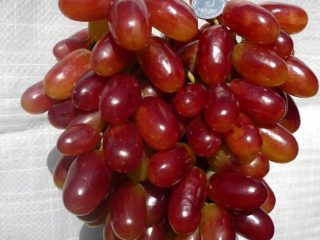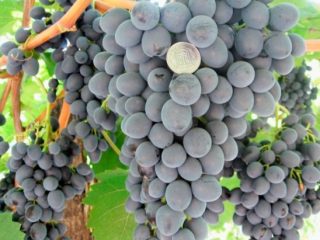Content
The Dubovsky pink grape is a young variety, but already enjoys well-deserved popularity among Russian gardeners. It is valued for its excellent taste, high yield and ease of care.
The grape was created by a Russian amateur breeder from the small village of Dubovka, Volgograd region, Sergei Gusev. He took varieties as parents Anniversary Novocherkassk and Delight Red. The hybrid Dubovsky pink not only absorbed all the best parental qualities, but also improved many indicators.
Variety characteristics
The description of the Dubovsky pink variety given by the breeder is truly amazing, which is confirmed by reviews and photos sent by gardeners. It’s not just the high yield that attracts attention to the plant.
Dubovsky pink grapes did not leave landscape designers indifferent. Grape bushes become especially beautiful when the bunches ripen. They are large, with glowing bright pink berries and become a real decoration of the site. Just look at the radiant bunch in the photo!
Hybrid form of early ripening grapes. From flowering to harvest it takes about 105-110 days. The first bunches are cut after August 15th.Of course, this is not an exact date, as it all depends on the growing region.
Description of the bushes
A grape variety with great vigor. The color of the ripened vine is reddish. The flowers are male and female, so Dubovsky pink is a self-fertile hybrid that does not require additional pollination by other grape varieties.
Propagated by root cuttings, the survival rate of which is almost 100%. Within a couple of years after planting the seedling, you can hope for a good harvest.
Description of bunches and berries
The Dubovsky pink grape variety, according to the description and reviews of gardeners involved in the crop, is distinguished by large, slightly loose clusters, which makes them look somewhat disheveled.
The brushes of the Dubovsky pink variety have a conical shape and side shoots, which gardeners call wings. The mass of the bunches reaches one and a half kilograms, although there are specimens of greater weight.
The berries are large, weighing around 20 grams. The length of the fruit ranges from 3.5 to 5 cm. The grapes have an interesting shape in the form of an icicle or an artistically curved cone with a sharp nose.
The pulp of the Dubovsky pink grapes is tender, crispy, juicy with a small content of seeds. There is a nutmeg aftertaste, but, as gardeners write in reviews, it is insignificant. The taste of the variety is excellent; it is not for nothing that during the tasting the grape variety was given a high rating - 9.3 out of 10 possible. Sugar in the fruits of the variety is about 21%.
The set fruits of Dubovsky grapes are pink green in color and remain so throughout the entire filling period.The rich pink color develops a few days before the end of ripening. A change in the color of the berries is a signal to cut the bunches.
To better imagine the Dubovsky pink grape variety, watch the video made by an amateur gardener:
Characteristics
Dubovsky pink grapes, as described by agronomists and reviews from gardeners, have a lot of advantages that distinguish the variety from other varieties.
Advantages
- Decorative. The plant with emerald green leaves looks great, and when the dark pink clusters begin to ripen, you can’t take your eyes off the bushes.
- Consistently high productivity. Fruiting begins 2-3 years after planting the seedlings. If you graft Dubovsky pink onto a vine of any variety with a well-developed root system, then the harvest can be harvested in the same year.
- Excellent taste. Table grapes are universal varieties. It is consumed fresh, juices, compotes, syrup, and vinegar are prepared. And what a delicious wine it turns out! Raisins are prepared from dried fruits.
- Preservation of berries. It is not necessary to immediately cut the bunches; they will not lose their taste and marketable properties if they hang a little. On the contrary, during this time they will gain the optimal percentage of sugar. After harvesting, the bunches can be stored for several months.
- Transportability. During long-term transportation, the berries do not spoil or lose their presentation, which is very attractive for farmers.
- Diseases and pests. According to the description, the variety is resistant to many grape diseases, although reviews sometimes write that plants are affected by oidium.
- Endurance.The Dubovsky pink variety survives at temperatures down to -24 degrees, so it is grown in the northern regions of Russia.
Disadvantages of the variety
Not many gardeners yet know about grapes, but those involved in the crop do not note any particular shortcomings; reviews are mostly positive. You should pay attention to normalizing the load on the vine. When overloaded, crop ripening slows down and ventilation is disrupted.
Planting grapes
Dubovsky grapes are heat-loving plants, so when planting you need to choose a well-lit place. The plant is also demanding of the soil: it must be fertile and breathable.
The variety has good resistance to cold, so it can be grown in temperate and northern latitudes. There should be no drafts on the site. Grapes love elevation. If there is no suitable place on the site, you will have to make a bulk bed.
Landing rules
As a rule, seedlings are planted in the fall. When digging a hole, they are guided by the parameters of the root system: it must fit freely. The depth of the hole is approximately 50 cm. The next grape bush is planted at a distance of at least 150 cm.
Drainage, for example, crushed stone, is poured at the bottom of the seat. Then the humus is mixed with potassium-phosphorus fertilizers and the hole is filled. To allow the soil to settle, it is moistened abundantly. At least 1.5-2 buckets of water are poured onto each hole.
Grape seedlings of any variety are subsequently watered and fed through a special pipe. It is placed in the center.
Before planting, grape cuttings are soaked in clay and manure for several hours so that the plant receives an additional stimulus and quickly takes root. There should be 2-3 buds left on the stems. Immediately after trimming, the ends are sealed with paraffin.
In the center of the hole, the earth is raised and a mound is made. This is a special “chair” on which the seedling is seated. The root system is straightened so that it looks straight down and sprinkled with soil. The surface is trampled down to squeeze out air from under the roots. Then water again with warm water. To prevent moisture from quickly evaporating, the soil under the grape bushes is mulched with straw, peat, humus or rotted sawdust.
Features of care
According to reviews from gardeners who have been working with the Dubovsky grape variety for many years, the plant is unpretentious. Caring for it comes down to traditional measures:
- watering and weeding;
- loosening the soil and mulching;
- feeding and treating bushes against pests and diseases;
- pruning and bush shaping.
The formation of the vine is particularly difficult, since it has great growth force. The variety is grown on a horizontal wire trellis. Growing seedlings are given the desired direction using tying.
Pests
The sweet berries of Dubovsky pink are very popular with wasps and birds. In order not to lose the harvest, you will have to spend some time protecting the bunches.
Popular measures:
- cover the grape plantings with a special net;
- hide each bunch in a gauze bag, as in the photo below;
- spray the plantings with a vinegar solution twice a month;
- make bait from beer or sweet water, into which wasps and ants will fall;
- fumigate the plantings with liquid smoke;
- destroy wasp nests in the area.
Diseases
It is not yet possible to say exactly what diseases the variety is susceptible to, since the grapes are still relatively young and have not been studied enough. But, according to reviews from gardeners, it has good resistance to many grape diseases.
Agronomists advise not to wait for any diseases to spread, but to take preventive measures. The fact is that different varieties of grapes are grown on the site, and they have different immunity. Treatments are carried out two or four times per season.
Dubovsky pink, according to gardeners, is sometimes affected by powdery mildew and oidium. In this case, the vine needs to be treated with sulfur or other special preparations. Diseases can be avoided if the grape bushes are well ventilated.















